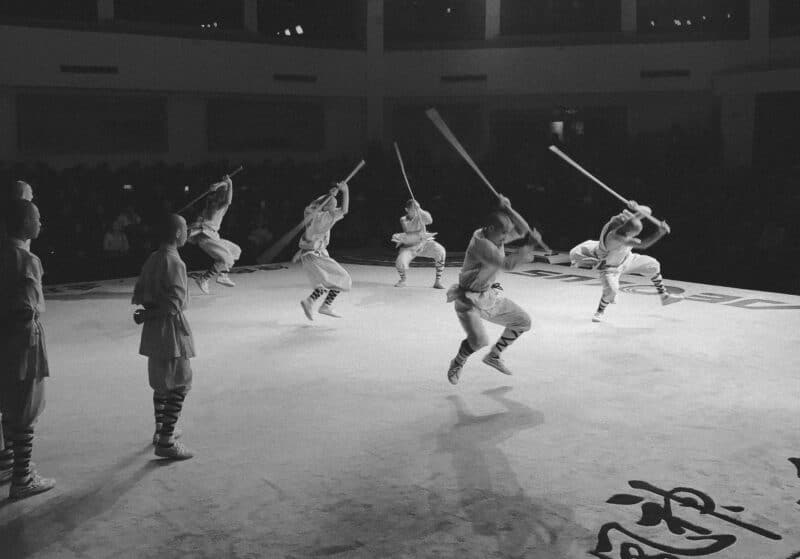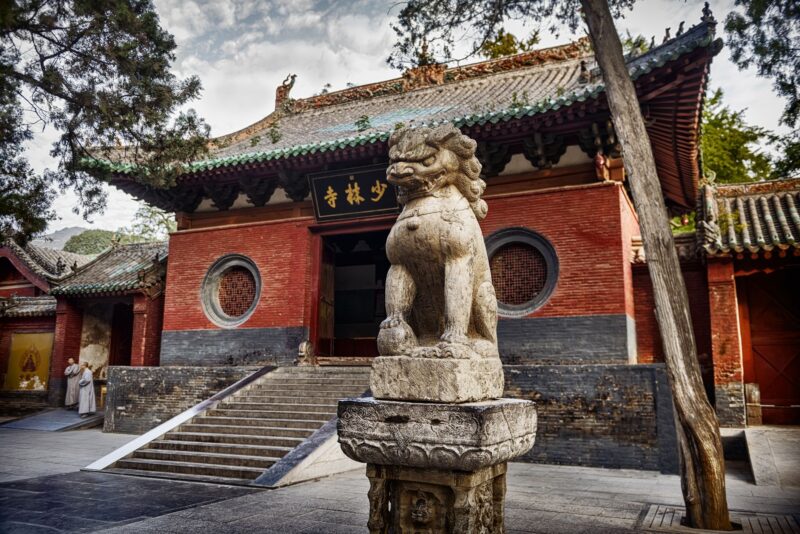The Sil Lum Temple destruction involves a Shaolin temple noted for its religious and military arts scholars. Many Ming dynasty generals and prominent Chinese families sent family members to study at the Sil Lum Temple. Ming generals and high officials often sought the rigorous military arts training for their sons. Specifically, from the warrior monks of this Shaolin temple. However, in the 17th century, political turmoil swept through China. Ming political power and economic might began to wane through decades of border warfare. The most costly was the protracted war in Korea against invading Japanese armies.
The once-close Ming ally, the Ching, grew stronger and bolder. They gained political control of the northern Chinese provinces in the early 1600’s. By the year 1644, the new Ching government controlled all major territories held by the former Ming Emperor. The fleeing government and military survivors of the now vanquished Ming Dynasty faded into the Chinese communities throughout China. The warrior monks (Ming supporters) of the Sil Lum Temple in Hunan province relocated to the southern Sil Lum Temple in Fukien province.
It is at the Fukien Sil Lum Temple that the five Chinese youth, each from prominent families, began their training under the warrior monks. These five were destined to become known as the famous “Five Elders of Sil Lum.” Four of the five were males and trained together in the Weng Chun Dein (Eternal Springtime Hall). Their names were Fung Doe Duk (eldest in learning rank), Bak Mei (eldest in biological age), Jee Shin, and Mew Hin.
The fifth youth was a female named Ng Mui and would join her four older Kung Fu brothers several years later. More than ten years passed before the five youths became mature Sil Lum experts. Taking an oath to restore the Ming Dynasty, the five experts began to train other Chinese loyalists in Kung Fu.


It was hoped that a trained army of Kung Fu fighters could be raised to overthrow the northern Ching barbarians. It was this same movement that gave birth to the most notorious Chinese secret societies known as the “Triads”. Of the five leaders (Five Elders), Bak Mei was not firmly behind the overthrow effort, nor was he really interested in the ever shifting political winds. Bak Mei began to feel the growing scorn from the other four elders for his non-alignment.
During the reign of the Qing emperor Kangxi (1662 – C1722), the warriors of the Xilufan revolt were so feared that the two ministers Kangxi who were ordered to end their attacks fled China rather than face either the mercilessness of the Xilu warriors or the displeasure of the emperor, which both often ended in beheading.
It was the 128 monks of the southern Shaolin temple who defeated the army of Xilu over 3 months in the year 1673 without suffering a single casualty. However, by doing so the monks had made enemies of those in the Qing Army and Qing Court who were embarrassed by how easily the Shaolin monks had succeeded where they had failed with an entire military force. Soon rumors began to spread about the threat posed by a power so great that it defeated the entire Xilu army with a force of only 128 monks.
The traditional religious sanctuaries across China soon began to unravel as the numbers of political refugees seeking new identities grew and began to seek refuge with the power and sanctuary of Ching tolerance to religious freedom within the Shaolin Temples. Like the Five Elders, many Ming political officials, hiding behind the veil of religion, still harbored political hate and malice towards the new Ching government. An increasing number of partisan attacks against the new Ching government’s establishments and officials caused increasing concern. The Ching government knew that these anti-Ching partisans used the religious monasteries as sanctuaries, especially the Sil Lum Temple.
Ching tolerance of the long-held tradition of religious sanctuary became unacceptable. This campaign of innuendo was wasted on Kangxi, who remained grateful to the monks, but the rumors had their intended effect on his successor, the emperor Yongzheng (1722-C1735), who ordered the Sil Lum Temple’s destruction. Troops were sent to attack the Monastery although their first attack was unsuccessful as the monks beat back the invading army. However, a man named Chan Man Wai, a recently appointed civil servant seeking favor with the new government, suggested a new plan.
In 1723, on the 6th day of the first new moon of the lunar calendar, Qing forces launched a sneak attack on the southern Shaolin temple, which began by bombarding the largely wooden monastery with a relentless deluge of burning arrows. Chan Man Wai paid off a few refugees inside the temple to burn it from the inside, while the Ching used the element of surprise, fire, firearms, bladed weapons, and the overwhelming number of Qing soldiers, the new government ordered thousands of monasteries destroyed and all Buddhist monks killed.
During their long travel, nearly nine hundred miles in the west-by-northwest direction, the Five Elders continued to refine their martial arts skill. They developed a number of refined fighting systems that required shorter periods of training. After 2 years of running and hiding from the Qing army, these fugitives of the cloth regrouped. They met at Mount Emei in Sichuan Province, in the year 1675. As one of the sacred mountains of China, Mount Emei was home to about 70 monasteries. They housed temples where the five clerics could blend in easily. Traveling for nearly a year-and-a-half after the Sil Lum Temple’s destruction, the Five Elders made their way to the western mountains of China. Traveling independently, the elders disguised themselves as Taoist priests and a nun.
Many thousands of monks, nuns, and religious followers lost their lives as the Ching army purged all suspected religious sanctuaries. After a long siege, the Qing destroyed the Sil Lum Temple in Fukien province. They killed 110 out of the 128 monks. The Great Shaolin Purge took 70 days as Qing forces hunted down the 18 survivors. The surviving warrior monks of Shaolin inflicted massive casualties on their Qing pursuers. Sadly, in the end their numbers were too great. Soon only five remained. This was The Chan (Zen) master Jee Sin, The nun Ng Mui, The Taoist Bak Mei, The Taoist Fung Do-Duk, and The Unshaved (lay) Shaolin disciple Miu Hin.
Although the Buddhists were being slaughtered throughout China by the Ching, the Taoists still enjoyed religious immunity. They were often not questioned by Ching troops. During their long travel, nearly nine hundred miles in the west-by-northwest direction, the Five Elders continued to refine their martial arts skill. They developed a number of refined fighting systems that required shorter periods of training. They decided that Bak Mei would infiltrate the Qing court. He would act as a spy while the others traveled throughout China. This was to establish an alliance of anti-Qing rebels.
After much time revolutionaries were trained by the five. They identified themselves to each other with a secret hand-signal. Which would come to be the formal greeting or courtesy of Wing Chun. In fact, the traditional greeting or courtesy common to many of today’s kung fu styles has two meanings. The first meaning recognizes the style’s Shaolin origins. The left hand symbolizing the union of the Green Dragon (the left hand). And the right hand symbolized the White Tiger. Both were the fighting animals of the Shaolin monks.
When the hands are reversed, the fist represents Yat (the Sun) known as the Sun Fist in Wing Chun. Furthermore, the palm represents Yuet (the Moon). Combined, these two characters mean “Bright” which reads and sounds like “Ming.” This is the name of the previous Dynasty. This was the one overthrown by the Manchurians. They formed the “Ching” Dynasty in its place. When a Wing Chun practitioner or secret society member saluted with a fist and open palm pushed toward you, they were saying “Return the Ming, overturn the Ching.” Obviously, this was not a sentiment shared by the Manchus. In modern times, this salute contains the history of Wing Chun. It symbolizes the respect and honor for those who teach us. Additionally, it represents the freedom that people fight for in every nation.
Fill out the form below, and our team will get in touch within 24 business hours. We look forward to seeing you soon!